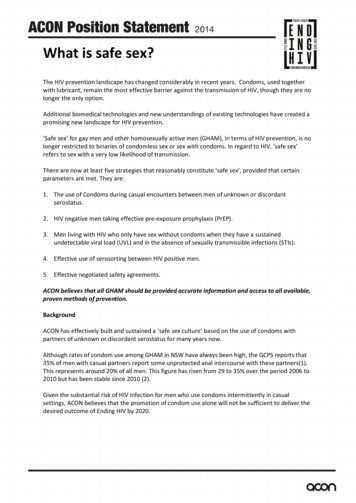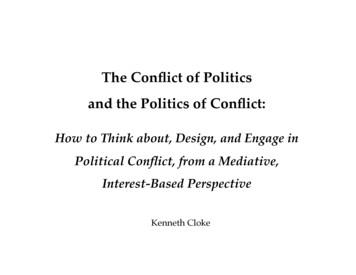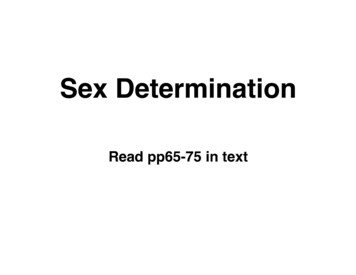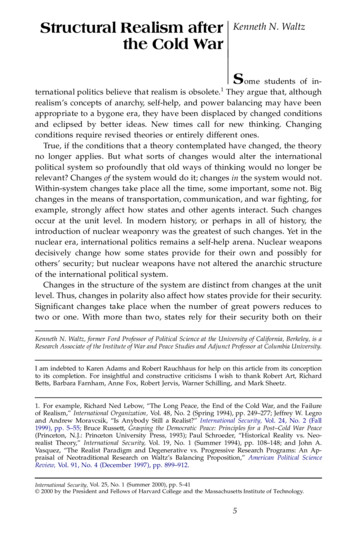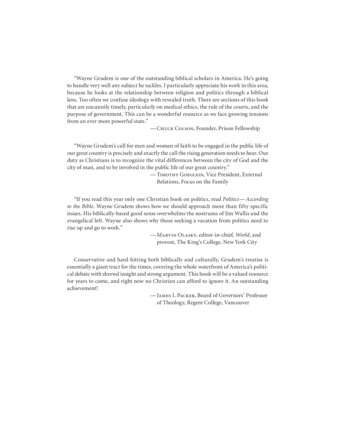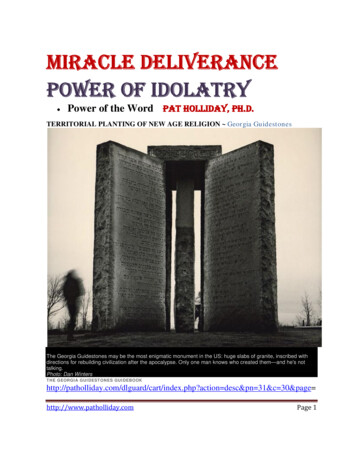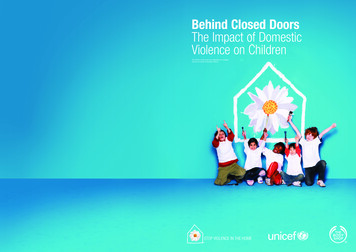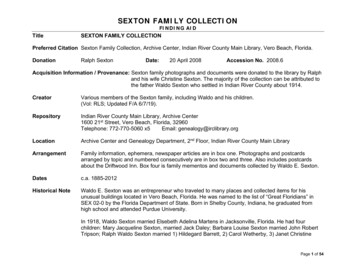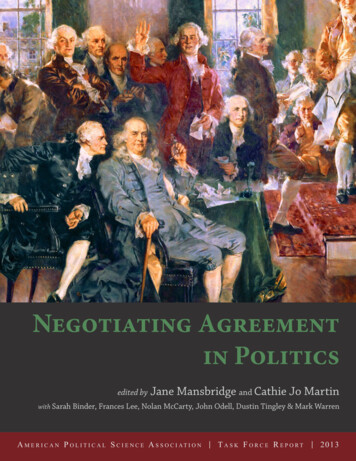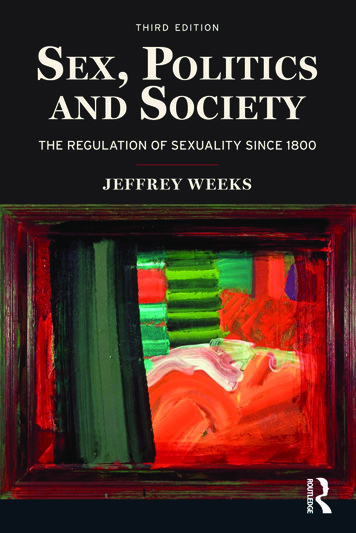
Transcription
Sex, Politics and Society
THEMES IN BRITISH SOCIAL HISTORYEdited by John StevensonNewspapers and English Society 1695–1855Hannah BarkerThe English Family 1450–1700R. HoulbrookeThe Professions in Early Modern England, 1450–1800: Servants of theCommonwealthRosemary O’DayWomen’s Agency in Early Modern Britain and the American ColoniesRosemary O’DayPopular Cultures in England 1550–1750Barry ReayCrime in Early Modern England 1550–1750 (Second Edition)J. A. SharpeGender in English Society 1650–1850: The Emergence of Separate Spheres?Robert B. ShoemakerLiterature and Society in Eighteenth-Century England: Ideology, Politics andCulture, 1680–1820W. A. SpeckCrime and Society in England 1750–1900 (Fourth Edition)Clive EmsleyPopular Disturbances in England 1700–1832 (Second Edition)John StevensonThe English Town, 1680–1840: Government, Society and CultureRosemary Sweet
Sex, Politics andSocietyThe regulation of sexualitysince 1800THIRD EDITIONJeffrey Weeks
First published 1981 by Pearson Education LimitedSecond edition 1989Third edition 2012Published 2014 by Routledge2 Park Square, Milton Park, Abingdon, Oxon OX14 4RN711 Third Avenue, New York, NY 10017, USARoutledge is an imprint of the Taylor & Francis Group, an informa businessCopyright 1981, 1989, 2012, Taylor & Francis.The right of Jeffrey Weeks to be identified as author of this work has been asserted by him inaccordance with the Copyright, Designs and Patents Act 1988.All rights reserved. No part of this book may be reprinted or reproduced or utilised in any form orby any electronic, mechanical, or other means, now known or hereafter invented, includingphotocopying and recording, or in any information storage or retrieval system, without permissionin writing from the publishers.NoticesKnowledge and best practice in this field are constantly changing. As new research and experiencebroaden our understanding, changes in research methods, professional practices, or medicaltreatment may become necessary.Practitioners and researchers must always rely on their own experience and knowledge inevaluating and using any information, methods, compounds, or experiments described herein. Inusing such information or methods they should be mindful of their own safety and the safety ofothers, including parties for whom they have a professional responsibility.To the fullest extent of the law, neither the Publisher nor the authors, contributors, or editors,assume any liability for any injury and/or damage to persons or property as a matter of productsliability, negligence or otherwise, or from any use or operation of any methods, products,instructions, or ideas contained in the material herein.ISBN 13: 978-1-4082-4830-0 (pbk)British Library Cataloguing in Publication DataA CIP catalogue record for this book can be obtained from the British LibraryLibrary of Congress Cataloging in Publication DataWeeks, Jeffrey, 1945Sex, politics, and society : the regulation of sexuality since 1800 / Jeffrey Weeks. -- 3rd ed.p. cm. -- (Themes in British social history)Includes index.ISBN 978-1-4082-4830-0 (limp)1. Sex customs--Great Britain--History--19th century. 2. Sex customs--Great Britain-History--20th century. 3. Great Britain--Moral conditions. I. Title.HQ18.G7W43 2012306.70941--dc232012006016Set by 35 in 10/13.5pt Sabon
For my mother,and in memory of my father
This page intentionally left blank
ContentsPreface to the first editionPreface to the third editionAcknowledgements to the first editionAcknowledgements to the third edition1Sexuality and the historianxxixivxv1Introduction 1Histories of sexuality 3Sexuality and power 7Sexuality and the politics of history 11The making of ‘modern’ sexuality 132‘That damned morality’: sexuality in Victorianideology27Victorian sexuality: myths and meanings 27Emergent patterns 31The domestic ideology 33Sex and class 393The sacramental family: middle-class men, womenand children47Masculinity and femininity 47Birth control 55Childhood 604Sexuality and the labouring classesMiddle-class myths, working-class realities 71Tradition, illegitimacy and proletarianisation 73The patterns of family life 82Respectability and its discontents 8971
viiiContents5The public and the private: moral regulation in theVictorian period100Forms of moral regulation 100Private morality, public vice 104Reform or control? 1106The construction of homosexuality119Homosexuality: concepts and consequences 119The sins of Sodom 122Moral, legal and medical regulation 125Identities and ways of life 134Intimate lives 1427The population question in the early twentieth century 158Population politics 158Maternalism 163Eugenics 165The influence of eugenics 1748The theorisation of sex182A new continent of knowledge 182Sex, science and society 188Havelock Ellis and sex research 191The impact of Freud 1959Feminism and socialism205Sexual radicalism and its limits 205Feminism and sexuality 206The morals of socialism 21410Sex psychology and birth control231Sex psychology 231International movements 236Parenthood and birth control 23911Towards a conservative modernityA ‘glorious unfolding’? 254Domesticity and family life 257Protecting purity 272Psychology and sex delinquency 280254
Contents12The state and sexuality296Welfare and citizenship 296Reproducing the population 297Towards the companionate marriage 301‘Wolfenden’ and sexual liberalism 30613The permissive moment321The transition 321‘Permissiveness’ 322Youth 325Women 330Ideologies 335The political moment 339The limits of permissiveness 34414Personal politics and moral conservatism357The ebbing tide 357Second-wave feminism 359The challenge of gay liberation 364The new moralism 367The Thatcherite experiment 374The AIDS crisis 38015A new world?391The changing sexual landscape 391Intimate pleasures 395Doing families 398A gender revolution? 402Becoming ordinary: the changing world of LGBT people 405Multicultural Britain? 412Values, agency and citizenship 415Index427ix
Preface to the first editionThis book has had a long gestation, and is intended to sumup a great deal of original research and a wide reading insecondary material. But as the historian Henri Pirenne noted, every workof synthesis inspires a new crop of specialised research, and I am clearlyaware of the provisional nature of this work, and the host of fresh questionsit raises.It should be said, however, that this book was never intended as adetailed or exhaustive account of all the multifarious patterns of sexualbehaviour. It is in essence, as the title and subtitle imply, a discussion ofthe forces that have organised and regulated sexuality within a particularhistorical period (roughly the period of industrial capitalism) in a particular geographical and political area (Great Britain, and chiefly that partsouth of Scotland). But I hope that some of the conclusions suggested willhave a wider resonance. Its working premise, set out in some detail inChapter 1, is that ‘sexuality’ is not an unproblematic natural given, whichthe ‘social’ works upon to control, but is, on the contrary, an historicalunity which has been shaped and determined by a multiplicity of forces,and which has undergone complex historical transformations.In order to account for some of the changes that have taken place, thebook, while largely chronological in form, avoids a simple narrative structure.It revolves around three broad issues: the meaning given to sexuality inVictorian society; the construction of sexuality as an area of social concern,scientific investigation and reforming endeavour in the late nineteenth andearly twentieth centuries; and the place of sexuality in twentieth-centuryconsciousness and social policy. In tackling these questions I am awarethat I have ignored other domains of interest, and have bypassed otherquestions that might fruitfully have been discussed. My excuse is that myaim has been a modest, but I believe vitally important, one: to delineatethe forces, ideas and social practices that have elevated sexuality into aprime focus of social concern over the past two hundred years.
Preface to the third editionSex, Politics and Society was first published in 1981, and soonestablished itself as a key text on the history of sexualityover the past 200 years. Refreshed by a second edition in 1989, whichincorporated some corrections and minor updates, plus a new Postscripton the 1980s, it has been continuously in print for thirty years. It waswritten when research on sexuality in Britain was still marginalised, andwhen the serious, theoretically informed and empirically rigorous, studyof sexuality was still in its infancy. In an important sense, therefore, thebook was a pioneering one, and in the original Preface I wrote of ‘theprovisional nature of this work, and the host of fresh questions it raises’.The book turned out to be less provisional than I expected, while thequestions it raised have continued to echo in contemporary debates. Thebook proved to be influential, both as a student text and as a significantcontribution to research in sexuality. It has been very widely cited overthe years, and is still being quoted in contemporary cutting-edge work. Ibelieve that both its empirical detail and fundamental analysis have broadlystood the test of time.More recent work and further research have of course modified someof the judgements I made thirty years ago, and there is now an abundanceof monograph and other specialist studies on various aspects of the periodwhich have contributed enormously to our knowledge and understanding.But there is still no obviously competing book that covers the whole of thesame period, and that is the main justification for this revised edition.One of my prime aims in writing Sex, Politics and Society was to treatsexual behaviour not as something esoteric and set apart, but as firmlylocated in wider social life. The book is as much a history of changingpatterns of family life, gender, domesticity and intimacy as of erotic lifeper se. At the same time it firmly places what had traditionally been seen asmarginal (notably homosexuality) within the broad stream of sexualities.The book strongly emphasises the historical construction of human sexualities and identities, and does so with reference to social context and social
xiiPrefaCe to the third editionchange – industrialisation, urbanisation, imperialism, scientific endeavours,the rise of the welfare state, the emergence of new social movements suchas feminism and gay liberation, the development of new forms of socialconservatism, and changing legal, medical and informal modes of sexualregulation. This emphasis on the importance of grounding the history ofsexuality within specific cultural contexts has now become the dominantapproach, and has produced an explosion of important work.But though I would argue that the main argument of the book asoriginally set out in 1981 remains valid, a new edition today has to takeaccount of two, closely intertwined developments. The first is the continuing evolution of the preoccupations, theories and empirical findingsof historical researchers and other writers on sexuality themselves. Theconcerns that seemed so urgent at the beginning of the 1980s have changedsignificantly in the face of events and of theoretical and political shifts.The dialogue with Marxism, that was still salient for many writers onsexuality in the early 1980s, was soon superseded by engagement with poststructuralism, post-colonial and critical race theories, queer theory andthe like, on the one hand, and the depoliticisation and mainstreaming ofhistories of sexuality on the other. Different questions, different preoccupations have led to new insights, changing perspectives and the challengingof older judgements, and these need to be fully engaged with.Second, the world of sexuality has been transformed since the 1980s,and the speed of change seems to be accelerating. Take one example: thefirst edition was published just as the first cases of AIDS were reported,but the book had been completed a year earlier, so there is no mentionof it in the first edition. No-one could have anticipated the impact of whatturned out to be a global pandemic. In the new concluding chapter to thesecond edition in 1989, I offered a preliminary, and rather pessimistic,assessment of its impact, especially in relation to attitudes towards homosexuality. The pessimism was justified in the sense that the pandemichas spread vastly since the early 1980s, with millions of deaths and muchsuffering. Yet the impact on the gay community was not as anticipated.There was, as Dennis Altman once observed, a legitimisation throughdisaster, while it became possible to live with HIV and AIDS because ofnew drug therapies. Another example: no historian in 1981 could havedreamed of the impact of the internet on sexual activity. Today, millionsof people converse freely across cyberspace about every aspect of the erotic,making irrelevant so many of the distinctions made by sexologists, theoristsand policy makers about sexual behaviour and sexual regulation.
PrefaCe to the third editionIn this new edition I have done my best to accommodate both thedevelopments in research and more importantly the changes in the worldof sexuality itself. Each chapter has been carefully updated to take accountof new scholarship and new debates. And an entirely new chapter hasbeen added to offer an analysis of key developments since the 1980s. Myintention has been to ensure that the book reflects both the theoreticalinsights that have made historical work on sexuality so exciting and challenging over the past thirty years, and the transformations in sexuality andintimacy which are creating a new sexual world in the twenty-first century.xiii
Acknowledgements to thefirst editionIowe an enormous debt to a large number of people, though itgoes without saying that no-one apart from myself can be heldresponsible for the final shape of the book.For encouragement, stimulation, moral support, intellectual sustenanceand/or practical assistance I have to thank: Sally Alexander, Victor Bailey,Michèle Barrett, Gregg Blachford, Keith Birch, Sue Bruley, Colin Buckle,Bob Cant, Jane Caplan, Emmanuel Cooper, Ros Coward, Leonore Davidoff,Anna Davin, Barry Davis, Philip Derbyshire, Françoise Ducrocq, AnnabelFaraday, Andy Fay, Kim Gale, Philip Jones, Jean L’Esperance, Jane Lewis,John Marshall, David Morgan, Frank Mort, Janet Parkin, Michael Rodgers,Sheila Rowbotham, Helen Rugen, Raphael Samuel, Ann Scott, Jo Sinclair,Lawrence Taylor, Lloyd Trott, Randolph Trumbach, Don Tylor, JudyWalkowitz, Simon Watney, Elizabeth Wilson, Roy Wolfe, Peter Wood,Nigel Young. Chris Cook provided the initial stimulus.I owe a special debt to Mary McIntosh and Ken Plummer who gave megreat encouragement and intellectual stimulation as colleagues and friends.I have to thank all the librarians and archivists who assisted me, withespecial thanks to the Departmental Record Officer at the Home Officewho gave me access to hitherto unavailable files.The Social Science (now Economic and Social) Research Council providedgenerous financial support for research projects which usefully employedme for a number of years. By suddenly ending such support at a crucialtime they also gave me the space to finish this book. I therefore owe thema double debt.I have to thank John Stevenson, editor of this series, and the publishersfor their immense patience and support for a project which grew longerand took longer as the years went by.Micky Burbidge and Angus Suttie lived with the enterprise from startto finish. I can simply thank them.My greatest debt is to the dedicatees, who made the whole thing possible.
Acknowledgements to thethird editionIt’s a rare privilege to be able to acknowledge again colleagues,friends and family thirty years after I first had the opportunityto do so. A lot has happened in those years, to me, to my loved ones, tosexuality research and to my co-workers in that field, and to the worldof sexuality itself. Yet the majority of people I thanked before are stillaround to thank once more for everything they have contributed to themaking of this book, and my other writings over the years. I do so now withgratitude and pleasure. Alas, some are no longer with us. All are missed,but none more than Angus Suttie, who died too soon in 1993. His lossstill resonates down the years, and his memory remains fresh.I must also thank the following who have contributed in their different ways so much to my life and my work since 1981: Peter Aggleton,Richard Allen, Dennis Altman, Maks Banens, Meg Barker, Henning Bech,Gerry Bernbaum, Chetan Bhatt, Claire Callender, Eric Chaline, Tom Claes,Raewyn Connell, Matt Cook, Andrew Cooper, Gill Davies, CatherineDonovan, Simon Duncan, Rosalind Edwards, Anna Einarsdottir, RichardEkins, Debbie Epstein, Mary Evans, Clare Farquhar, Liz Fidlon, JaneFranklin, Gert Hekma, Anthony Giddens, Val Gillies, Harry Goulbourne,Beverley Goring, Leslie Hall, Jane Harmer, Brian Heaphy, Gert Hekma,Janet Holland, Deian Hopkin, Jackie Jones, Jonathan Ned Katz, DaveKing, Brian Lewis, Karin Lutzen, Stina Lyon, Anamika Majumdar, DerekMcGhee, Rommel Mendes-Leite, Theo van der Meer, Martin Mitchell,Mike Molan, Henrietta Moore, Gareth Owen, David Paternotte, KevinPorter, Paula Reavey, Robert Reynolds, Tracey Reynolds, Diane Richardson,Philippe Rougier, Gayle Rubin, Lynne Segal, Steven Seidman, Carol Smart,Yvette Taylor, Donna Thomson, Rachel Thomson, Matthew Waites.From the mid-1990s I was gainfully employed in various senior posts atLondon South Bank University. I have to thank my colleagues and studentsfor all their support and stimulation during what now seem in the glow ofhistory exciting times of growth and innovation.
xviaCknowledgements to the third editionIn 1981 I thanked the Social Science Research Council for their support,and observed that withdrawal of that support inadvertently gave me thespace to finish this book. Since then the Economic and Social ResearchCouncil (as it is now known) has provided me with new opportunities forresearch, some of which is reflected in this edition. I thank them for beingthere, and for continuing to support research on sexualities and intimacy,often against the odds.My gratitude to all my families grows ever greater as the years go by.My old friend Micky Burbidge has suffered severe ill health in recent years.His friendship has remained unstinting, and once again I have pleasure inthanking him for that.My greatest debt as ever is to my life (and civil) partner, Mark McNestry.To him I give my love and gratitude. Our dog Ziggy also deserves lots ofhugs for being there.My mother remains a constant source of love and support. I re-dedicatethe book to her, and to the memory of my father.
CHAPTER 1Sexuality and the historianIntroductionWhat exactly is a history of sexuality a history of? It willsurely have something to say about desire, that elusive butinsistent psychic energy which torments as much as it drives human action.It must address sexual practices, in and outside the bedroom, those thattransgress the norms of a particular society and period as much as thosethat quietly or ostentatiously conform to them. It must deal with homosexuality as well as heterosexuality, and the range of other categories thatorganise our thinking about sexual life. And we must understand that suchcategories have their own histories and productive effect on individual livesand social definitions. A history of sexuality must be concerned with theshifting exigencies of reproduction but also the diversity of sexual needs andpractices that flourish alongside the patterns of procreation. Sexual historymust be acutely alive to the inextricably linked but different experiences ofwomen and men, to gender hierarchies and changing gendered meaningsthat determine what is meant by masculinity and femininity, and how theyare lived, at any particular time. And it must be alert to the economic, social,geographical, religious, political, ethnic and racialised factors that shapesexual beliefs, practices and cultures.In other words, a history of sexuality is a history without a single, clear,fixed object. It necessarily embraces a range of different elements. The dangeris that there are too many subjects which are relevant to a comprehensivehistory of sexuality. We need to study the vast range of social factors –family structures, marriage codes, legal systems, social institutions, sexualcultures, identities, rituals, beliefs, discourses and ideologies – that shape
2SEX, POLITICS AND SOCIETYand embody sexual meanings, determine the power relations that act onand through sexuality, and make possible different ways of living erotic life.Sexuality is about the body, but it is also about what goes on in the mindand in society. Sexuality gains its significance for history precisely becauseof the way it is shaped and embedded in social life. Above all, sexualityhas to be understood as a complex set of social practices that change overtime. From this perspective, writing about the history of sexuality andsexual change is more than a study of a particular aspect of natural life.It is a key to understanding the social relations and ways of life at anyparticular time.A historical approach to sexuality is one that seeks to understand itas a product of shifting historical circumstances rather than biology ornature. This has been a central element of the new sexual history whichdeveloped from the 1970s, and of which this book is itself an example.Sex in history, an American historian, Vern L. Bullough, remarked in theearly 1970s, is a ‘virgin field’. ‘Historians have been reluctant’, he wenton, ‘exceedingly reluctant, to deal with such a delicate topic.’1 The firstedition of this book took up the challenge in that comment, and was apioneering attempt to offer a survey of the terrain of sexuality in recentBritish history. It certainly felt a delicate topic at the time. Since then muchhas changed. The new sexual history of recent years has challenged ourignorance of the subject, and the veils of discretion surrounding the subjecthave mercifully lifted. The sexual history that emerged in the 1970s tooksexuality seriously. In doing so, it sought to extend the range of sexualactivities investigated – for example, taking marginalised and transgressivesexualities as seriously as normative forms – and to deepen our understanding of the complexities of sexual relations. As a result, sexuality isincreasingly, and rightly, now seen as a critical element for understanding British history – and indeed the significance of sexuality to Britain’simperial expansion and place in the world. There is a rich and flourishingscholarship about a great range of sex-related life, and our ignorance aboutsexual life has been fundamentally challenged. The territory (to continueBullough’s metaphor) is now well populated, with large and flourishingsettlements and some glorious buildings. This book seeks to reflect andbuild on this rich and insightful scholarship. It remains the only full studyof the past two hundred years or so of British sexual history. That, I trust,justifies this new, fully revised edition.2 In this chapter I explain some ofthe influences that went into the making of the book in its first incarnation,and also explore the ways in which the field has developed in many productive ways in the past thirty years.
SEXUALITY AND THE HISTORIANHistories of sexualityVarious attempts at an historical exploration of sexuality had been madebefore the 1970s, though they largely remained marginal to traditionalhistorical explanations, and for long carried a stigma, making the writersmorally suspect if they moved too far from an appropriate ‘scientific’detachment. Historical overviews had been appearing since at least the timeof the great pioneering sexologists and anthropologists of the late nineteenthand early twentieth centuries; and what were published then were workswhich have been profoundly influential, not only in describing but in constituting and delineating the areas to be discussed. They usually displayedone of two broad approaches, though they were not mutually exclusive,and there was, in practice, a considerable overlap between the two.3The first can be described as the ‘naturalist’ approach, and the classicexample was the highly influential work of the great pioneering Britishsexologist Havelock Ellis, especially his majestic Studies in the Psychologyof Sex, published, though not in Britain because of legal problems, fromthe 1890s to the 1920s.4 This is a vast, valuable chronicle of sexual behaviours and beliefs, essentially descriptive in form, ostensibly classifyingand categorising sexual forms that exist ‘in nature’, but also documentingtheir history in various cultures and periods. Most subsequent works builton this approach, and the result was an extremely important garnering ofsexual knowledge. What the volumes were less successful in doing was toprovide coherent explanation of the variations they described, nor accountfor changes in mores and consciousness. They were basically historiesof reactions to sexuality, rather than attempts to explain why and howsexuality shaped human societies.The second broad approach was what Ken Plummer called the ‘metatheoretical’,5 and usually derived from a psychodynamic or neo-Freudiantheory. Its major difficulty was the opposite of the naturalistic problem,in that by and large theoretical constructs took precedence over empiricalevidence. The dangers of such an approach could be seen at its most extremein the popular historian Gordon Rattray Taylor’s neo-Freudian interpretation of Sex in History: ‘The history of civilisation is the history of a longwarfare between the dangerous and powerful drives and the systems of taboosand inhibitions which man has erected to control them.’6 He accounted forchanging attitudes in terms of largely unexplained swings between ‘matrist’and ‘patrist’ cultures, leaving us with a grandiloquent but unsubstantiatedcyclical theory of social change. Such an approach was influential evenamongst well-established academic historians, so that Lawrence Stone, for3
4SEX, POLITICS AND SOCIETYexample, hinted at such a cyclical explanation in his own work on TheFamily, Sex and Marriage, published in 1977: ‘In terms of both sexualattitudes and power relationships, one can dimly begin to discern huge,mysterious, secular swings from repression to permissiveness and backagain.’7 This sort of approach, by attempting to explain everything, endsup by explaining very little, especially as the swings remain ‘mysterious’.Even such a sensitive cultural critic as Steven Marcus in The Other Victoriansrelied on a simplistic Freudian explanation, which by and large distortedrather than clarified. In a prefatory motto for the book he quoted fromFreud to the effect that ‘perhaps we must make up our minds to the ideathat altogether it is not possible for the claims of the sexual instincts to bereconciled with the demands of culture’.8 What for Freud was a statementof the tragic human dilemma, that civilisation requires the repression ofhuman possibilities, became a weak explanation of contingent historicalshifts. So Marcus’s explanation of nineteenth-century pornography, forinstance, was in terms of this conflict between the overpowering demandsof the sexual drive and a social fabric disrupted by massive change.What we can see in both these approaches was what came to beknown in the 1970s and 1980s as an ‘essentialist’ view of sexuality: sexconceptualised as an overpowering force in the individual that shapednot only the personal but the social life as well. It was seen as a driving,instinctual force, whose characteristics were built into the biology ofthe human animal, which shaped human institutions and whose will mustforce its way out, either in the form of direct sexual expression or, ifblocked, in the form of perversion or neuroses. Richard von Krafft-Ebing,the Austrian founding father of sexology, the would-be science of sex,expressed what became the orthodox view in the late nineteenth centurywhen he described sex as a ‘natural instinct’ which ‘with all conqueringforce and might demands fulfilment’. It was, as the language stronglysuggests, a basically male drive. It was also a firmly heterosexual drive.William McDougall in the 1920s spoke representatively of the ‘innatedirection of the sex impulse towards the opposite sex’.9Behind such arguments was the assumption of what John H. Gagnon andWilliam Simon, the pioneers of new sociological approaches to sexualityin the 1970s, called a ‘basic biological mandate’ that pressed on, and somust be firmly controlled by the cultural and social matrix. This traditionalapproach had the apparent merit of appearing commonsensical, accordingwith our own intimate experiences. And it was largely unquestioned in thework of most earlier theorists of sex, from naturalists and Freudians totaxonomists like Alfred Kinsey (in his concept of ‘sexual outlet’) and the
SEXUALITY AND THE HISTORIANresearch clinicians such as William Masters and Virginia Johnson (in theirdescriptions of physiological responses). Moreover, the instinctual (or ‘drivereduction’) model was embraced by all shades of opinion, from the conservative moralist anxious to control this unruly force to the Freudian left(most famously Wilhelm Reich and Herbert Marcuse) wanting to ‘liberate’sexuality from its capitalist and patriarchal constraints.Against this, Gagnon and Simon argued in their book Sexual Conductthat sexuality was subject to ‘socio-cultural moulding to a degree surpassedby few other forms of human behaviour’.10 This counter-intuitive proposalhad a major impact because it brought what was generally seen as the mostnatural and unchanging of human attributes within the realm of social –and fully historical – invest
Literature and Society in Eighteenth-Century England: Ideology, Politics and Culture, 1680-1820 W. A. Speck Crime and Society in England 1750-1900 (Fourth Edition) Clive Emsley Popular Disturbances in England 1700-1832 (Second Edition) John Stevenson The English Town, 1680-1840: Government, Society and Culture Rosemary Sweet. Sex, Politics and Society The regulation of sexuality since .
